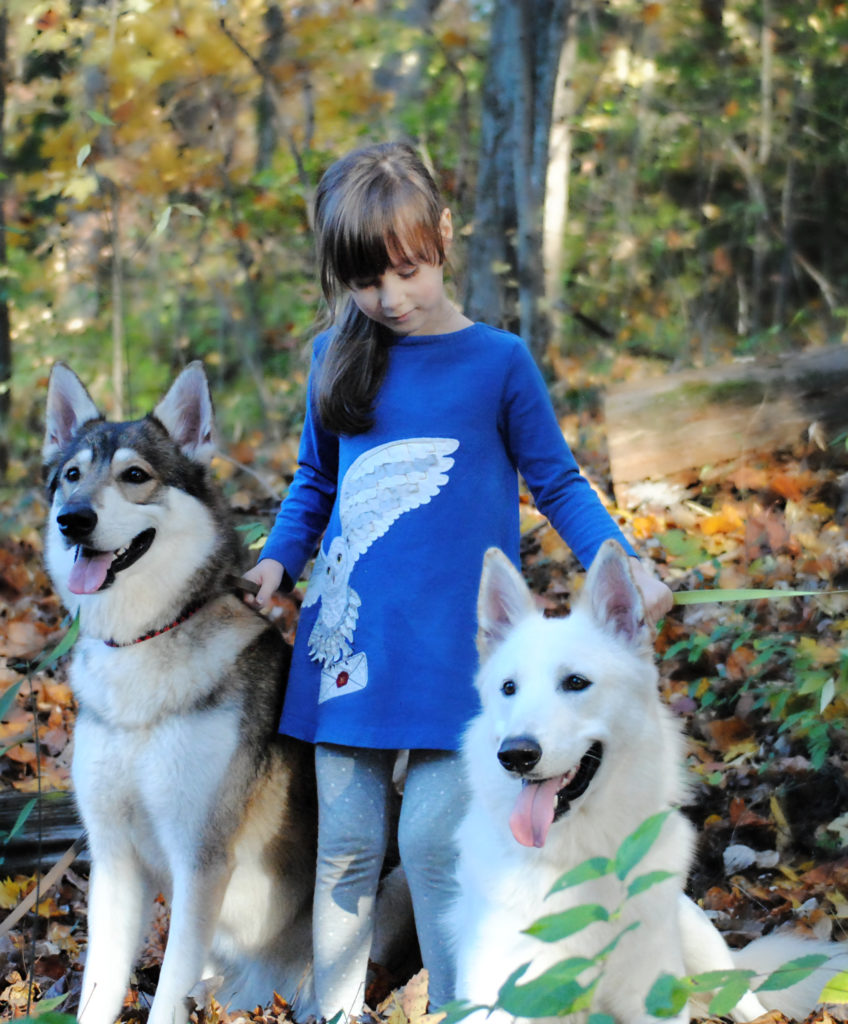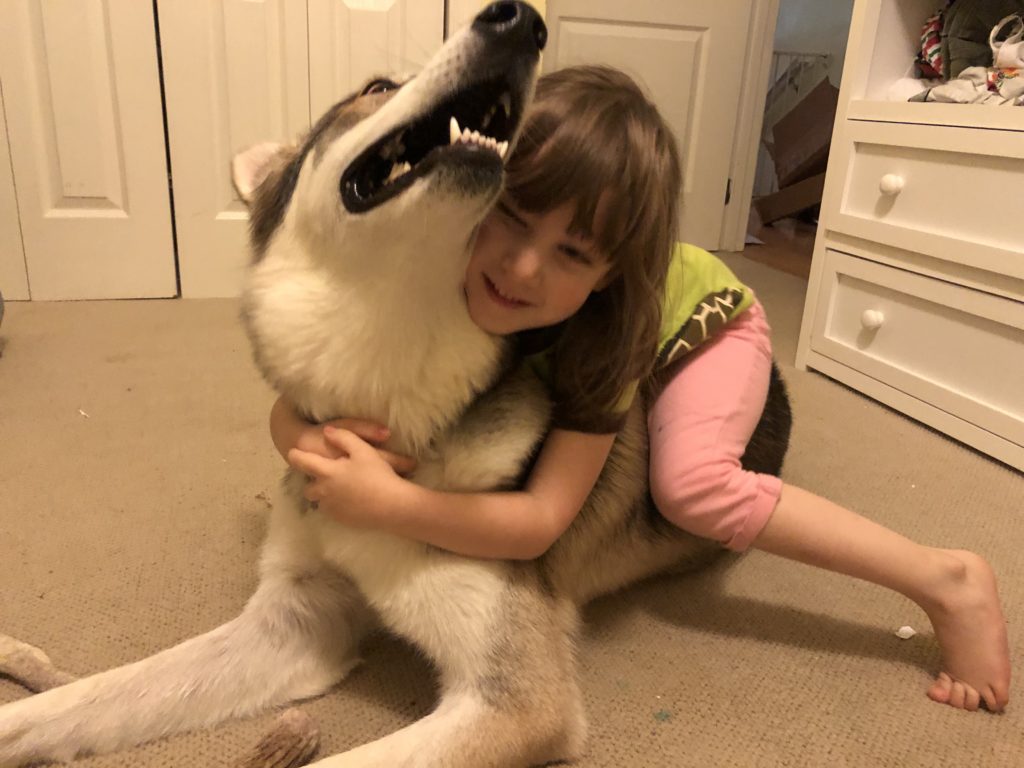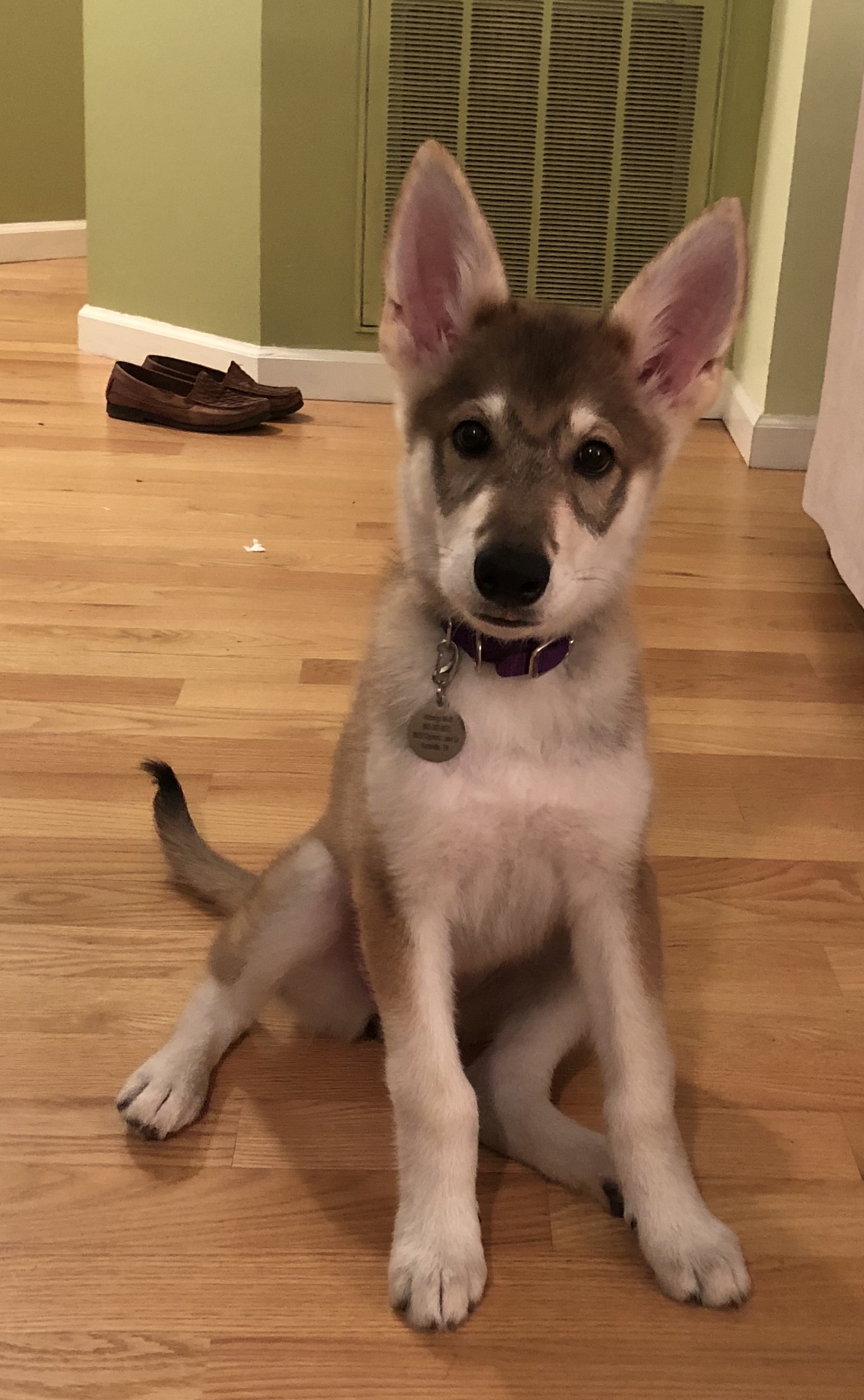Tamaskan Temperament

Tamaska means “Mighty Wolf” in North American Indian language. Tamaskan breed originated from England with the two founders, Blustag and Blufawn. Both founders, although British, moved their breeding establishments to Finland to race their dogs in arctic conditions, and many Finnish dogs were integrated into the breeding program.
The Tamaskan is sweet natured and good with children and small pets, this has made them a favourite with UK wolf lovers.
Tamaskan dogs are highly intelligent and need constant mental stimulation, but with the correct training they can excel in obedience, agility and even heelwork to music as well as their original function as a sled dog.
A well-bred Tamaskan is calm, sensible, and patient. Some are more outgoing, others more introspective.
Adult Tamaskan are calm and quiet indoors, youngsters are boisterous. This breed needs daily exercise, we recommend at least 45-60minutes of exercise daily for a fully grown adult dog, puppies would need less.
Companionship is of prime importance to this sociable breed. Left alone too much, he becomes dispirited — and destructive.
Tamaskan are generally relaxed and accepting of everyone, but some may be reserved and requires early, frequent excursions into the world so that he grows up to trust and respect people and other dogs.
Most Tamaskan are fine with other animals when raised with them, but there is some same sex aggression, which can be frightening to experience because of this breed’s size and power, again early socialisation is key to raising a well adjusted adult.
History of the wolf-dog and the Tamaskan breed

If you are here, you probably like many of us, want to have a dog that looks like a wolf but with an expectable good temperament, suitable for a family dog. So, in the early ’80s, breeders tried to replicate the wolf look in dogs by mixing Siberian Huskies, Alaskan Malamutes, and German Shepherds. In 1988 a group of people formed The Northern Inuit Society (NI). Lynn Hardey of Blustag Kennel, the founder of Tamaskan breed, joined the committee of this society and purchased the first two breeding dogs from there. The society split in two very soon, due to breeders’ selections of what look quality they want to pursue in their dogs. Some of the committees stayed in NI, however, the other had to choose a new name, which they called Utonagan. Lynn Hardey later joined the committee of Utonagans.
There were some health issues, such as poor hips that were noted by Lynn in those dogs. Poor hips and hip dysplasia is a high risk in many known breeds, such as German Shepherds, Retriever, Labradors, and many more. Most affected dogs are born with the disease and it is genetic; so there are certain dog breeds prone to hip dysplasia. There is no way for pet parents to prevent the condition. However, since the disease is genetic, if you don’t breed the carrier of the gene, it should disappear eventually. You can see how this protocol has a costly impact in the breeding process. Especially, since the hip score can be tested only from 1 year or older. Lynn still was determined to implement a strict testing protocol for hip-score for the British and International Utonagan Society.
Soon after that, Lynn began researching the pedigrees of her NI and Utonagan dogs. After digging, she discovered that dogs’ names were changed or parents altered entirely to cover up mother-son and brother-sister mating(inbreeding). Lynn realized that the only way to progress with the breed and to save it from the health issues is to dissociate from the scandal surrounding the alteration of pedigrees. So she gave her dogs new registered names and continued to selectively breed to improve health issues and keep strict records of mating and pedigrees. Eventually, Lynn’s dog started to look different from the Utonagan’s Society dogs.
The Utonagan Society once again had differing ideas on looks and what new bloodlines they should add to their dogs. This brought the end to the Utonagan Society.
Lynn Hardey continued her hard work on these dogs and in 2006 she moved to Finland with her Blustag dogs where she used Finnish dogs to refresh the bloodline of her dogs. In February 2006, The Tamaskan Dog Registry was formed with the founder Lynn, sitting at the chairman and her daughter, Jennie (Blufawn Kennel) as the secretary. The same strict rules and regulations enforced by the British and International Utonagan Society were carried over with the addition, DNA testing became mandatory for all breeding dogs. It was important to Lynn that all records were accurate from the very beginning of the breed for any future KC recognition and for peace of mind that future breeders would not be able to breed related dogs with false pedigrees. All dogs used in the Tamaskan Dog breed from the very first foundation dog, to ‘one time only’ stud dogs have been DNA profiled and recorded. There is a complete record of each dogs all the way back to the founding
Although, the Tamaskan breed has been exported to many countries since 2007; such as Finland, The Netherlands, Germany, Sweden and France, Italy, Hawaii, Norway, Canada, Australia, Bulgaria, USA and a few more, there are still very few countries and breeders working with a very limited amount of Tamaskan dogs, leading to high demand and long wait lists for these puppies. Unfortunately, some breeders dropped protocol and standards that was originally set up by the original breeder and mix their tamaskans with new bloodlines to increase their stock which noticeably changes the breed look, health and the pure bloodline. There are several breeders representing these dogs as Tamaskans, and though they may have some resemblances, they are not Tamaskans as originally founded. There are breeders in the USA, that claim they sell Tamaskans, and are the original Tamaskan registry, though many of their dogs, did originally come from Lynn in UK, and were associated with original registry, have parted ways, outcrossed, and started separate registries. We are the only USA breeder, maintaining standards and protocols, set by the actual Original Tamaskan Dog Breeder and Registry.
Our Goal
Our goal is to introduce this beautiful, sweet, and and very intelligent breed in pureblood, as was intended by the original breeder, now in America, while keeping the high breeding standards, including breeding and health standards of the original breeder.

Our puppies are born and raised inside, with daily handling and Early Neurological Stimulation. Our puppies socialized, and we offer lifelong breeder support, and will always take back a dog if needed at any age.
Why is Alpha Tamaskans more expensive than other breeds?

Tamaskans are a rare breed. There is no way to produce lots of dogs from a limited number of purebred dogs. It takes careful planning to find dogs that are diverse enough in lineage, yet still pure. We, unlike many American Breeders, must obtain our dogs from over-seas. This costs a lot for airlines flights, veterinary checks, import duties, taxes and broker fees and other travel arrangements. Also, due to the high standards maintained with the breed, all dogs have to have genetic testing and hip testing. These tests are very expensive. Also, all Alpha-Tams have to maintain European testing standards as originally out-lined in the breed from Europe. This means that we must use tests accepted and used in the EU, such as the BVA. This coordination with International labs, committees and vets requires additional costs and time.
Tamaskans are high-energy and high-intelligence dogs. The dogs require more stimulation, exercise, attention and time than other breeds. They also have to have adequate space. This all increases the costs of care. We feed our breeding dogs exceptionally high-quality diets. Not all dog foods are equal. A good dog food can be 2x the cost of a inexpensive common food. And an excellent dog food can cost 3-4 x more than regular foods. However, we know that is not even enough. We feed our dogs approximately 40% of their diet with human food. And we do not mean table scraps. It is not just the same food people eat, it is same food humans that eat healthy prepared foods, eat. Alpha-Tam’s owner is even degreed in Nutrition and Dietetics. Tamaskans love to chew. We keep a steady supply of high-quality chews and bones for the dogs. Most pet market and grocery store chews are not acceptable for most dogs and can actually be dangerous. They also go through a steady supply of toys. They are strong dogs and can make short work of even the most durable toys. And as we said, they needs lots of entertainment and stimulation. We could not sell the puppies for less unless we wanted to lose money. If you are buying a Tamaskan for less, we believe, it is likely not a real Tamaskan, or somewhere something would have to be sacrificed or neglected.